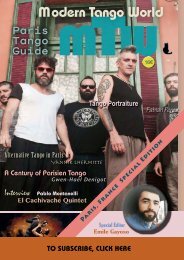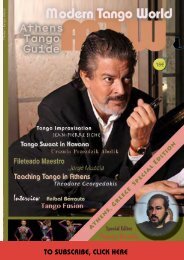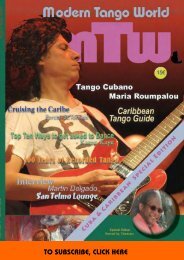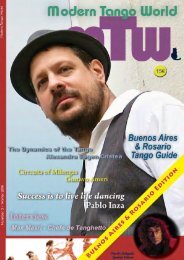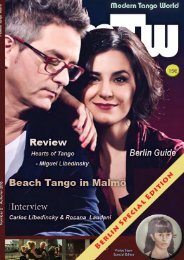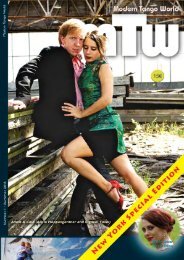Modern Tango World #8 (Moscow)
Moscow Special Features Magnolias on the Snow Andrey Klimovich 03 Milonga Chique Evgeny Morozow 10 The New Moscow Polina Yegurnova 14 Guide to Tango in Moscow 18 Sunset Tango Collages Denise Mumm 22 Interview with Jonathan Goldman Marco Buso 26 The Other Night at La Viruta Daniel Pereyra 31 Book Review: Tango Awareness Alexandru Eugen Cristea 34 Why There is so Little Dance in Dancing Tango Veronica Toumanova 35 New Tango Music Arndt Büssing 38 Tango Moves: Boleos (Voleos) Raymond Lauzzana 42 Letters to the Editor 46
Moscow Special Features
Magnolias on the Snow Andrey Klimovich 03
Milonga Chique Evgeny Morozow 10
The New Moscow Polina Yegurnova 14
Guide to Tango in Moscow 18
Sunset Tango Collages Denise Mumm 22
Interview with Jonathan Goldman Marco Buso 26
The Other Night at La Viruta Daniel Pereyra 31
Book Review: Tango Awareness Alexandru Eugen Cristea 34
Why There is so Little Dance in Dancing Tango Veronica Toumanova 35
New Tango Music Arndt Büssing 38
Tango Moves: Boleos (Voleos) Raymond Lauzzana 42
Letters to the Editor 46
Create successful ePaper yourself
Turn your PDF publications into a flip-book with our unique Google optimized e-Paper software.
By 2003, the number of tango dancers had grown<br />
from a handful to a few hundred. The first Argentinean<br />
tango festival, Nights of the Milongueros. was held<br />
by the teachers-enthusiasts. This festival continues to<br />
be held to this day.<br />
During the first decade of the new millenium, most<br />
<strong>Moscow</strong> tangueros went to hangouts where first<br />
milongas and performances by Argentine teachers<br />
were held. At that time, it all seemed very exotic.<br />
In the following years, the first wave of students became<br />
tango teachers. They opened several new tango<br />
schools. During htis same period, the first permanent<br />
foreign teacher of tango Diego Arizaga established<br />
himself in <strong>Moscow</strong>. He came from Buenos Aires to reside<br />
and work in Russia. His students formed a second<br />
branch, as they, in their turn, also became teachers. In<br />
this way, the number of tango schools grew to five,<br />
then seven, and then ten.<br />
Early on, the teaching methods in <strong>Moscow</strong> were greatly<br />
influenced by the Argentine dancers, Carlos Gavito,<br />
Gustavo Naveira and Graciela Gonzalez. Later. the<br />
influence came from the lessons of Javier Rodriguez,<br />
Geraldine Rojas, Horacio Godoy and Sebastian Arce.<br />
Around 2006, the phrase dancing in style Villa Urquiza,<br />
could be heard at <strong>Moscow</strong> milongas, for the first time.<br />
The fascination with this idea is noticeable in magazine<br />
publications and flyers of that time. It should be noted<br />
that the eponymous district of Buenos Aires has not<br />
patented any special manner of dancing. The term Villa<br />
Urquiza style was coined by two teachers from the US<br />
and is not entirely meaningful. Except for the fact that<br />
in the 70s in the barrio Villa Urquiza there were large<br />
milongas and a recording studio operated there.<br />
The economic situation in Russia gave an opportunity<br />
to start small business during the period 2005-2010.<br />
As a result, more and more tango-schools opened.<br />
The increase in the scope of teaching and the number<br />
of milongas that were conducted could also be explained<br />
by the trips of tangeros to Buenos Aires. The<br />
tango began to influence the private life of the dancers,<br />
encouraging some of them to live in Buenos Aires<br />
for a few years or for life.<br />
— 17 —<br />
TO SUBSCRIBE, CLICK HERE




